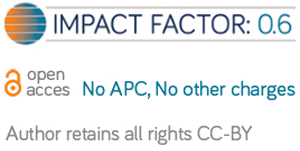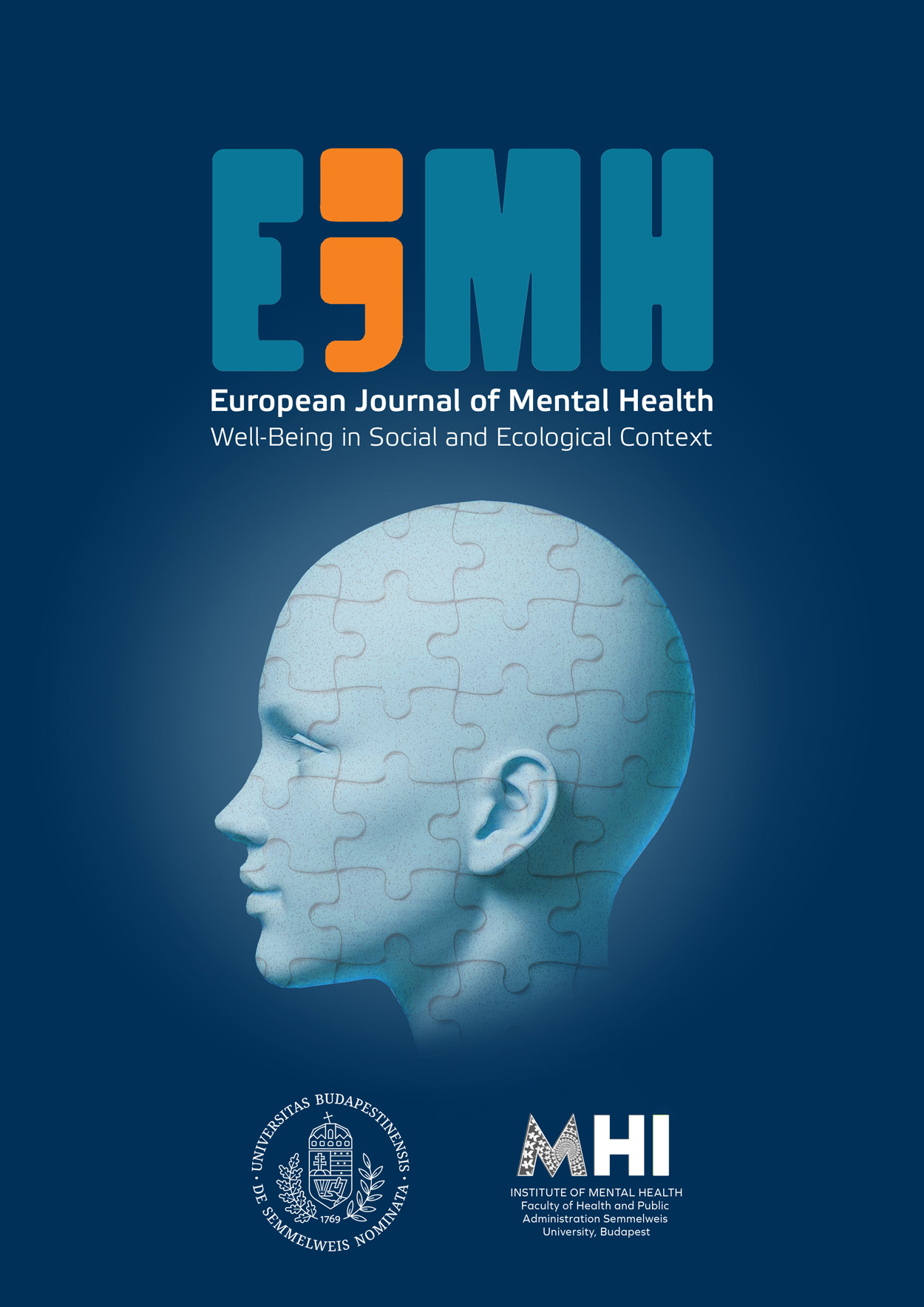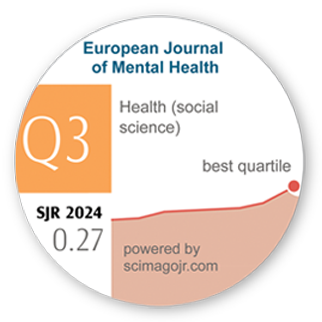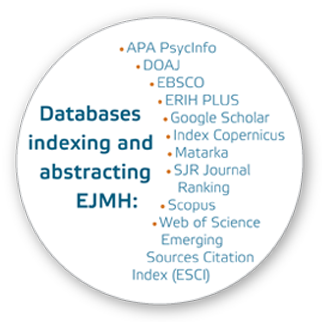Author Guidelines
From 21 July 2022
Updated: 16 September 2025
As the European Journal of Mental Health is an interdisciplinary Journal, accepting submissions from both the medical as well as social and behavioral sciences, we refer to the guidelines for both disciplines in our rules.
Before submission
Before submitting a manuscript, please read the Journal’s scope and aims, its preferred topics, and the types of manuscripts accepted. The Journal only accepts papers that fit its profile for the review process.
Before submitting a manuscript, each author should read and fill in the Authors’ Form, which also lists the Journal’s various policies.
In order to be accepted for publication, manuscripts (except conference abstracts or PhD theses) must be previously unpublished both electronically and in print, must differ substantially from other works of their author(s) published elsewhere, and must not be simultaneously submitted to other journals.
We can only accept manuscripts that do not violate the Declaration of Helsinki (1975, revised 2008) and where the human studies have been approved by a competent ethics committee. Also we can only accept those animal studies which follow the ARRIVE guidelines (Animal Research: Reporting of In Vivo Experiments).
Before submitting your manuscript, please read the Author Guidelines and prepare your manuscript accordingly.
Submission of the manuscript
Manuscripts should be submitted via email: ejmh-editor@semmelweis.hu, after having prepared the material in accordance with the Authors' Guidelines.
The European Journal of Mental Health does not charge a submission fee.
The checklist below can assist you in making sure that your submission is complete.
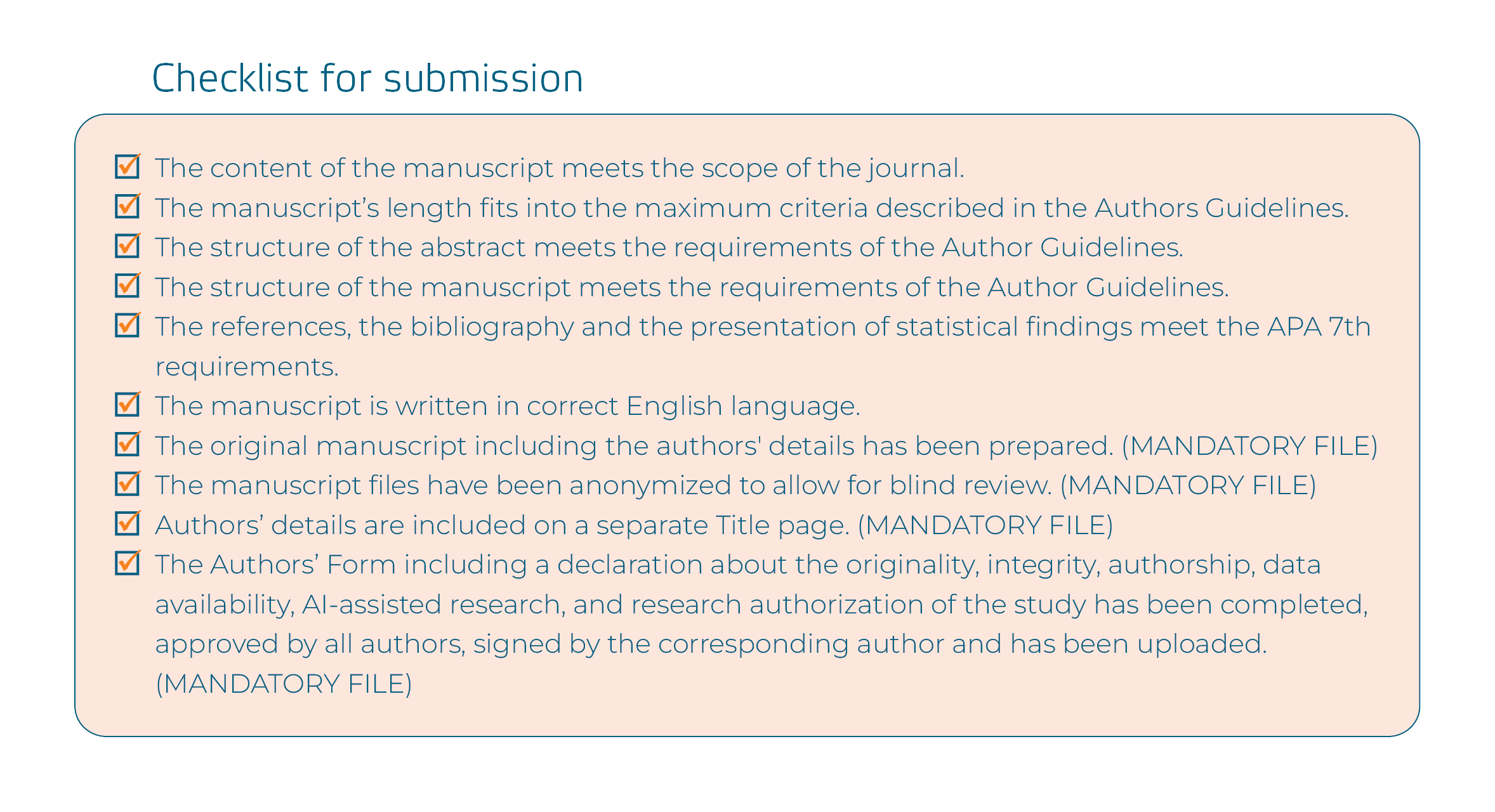
Preparing the manuscript
The European Journal of Mental Health
- expects the manuscripts to be submitted in correct English, approved by a native English-speaking proofreader;
- the content should meet the Journal’s scope and relevant topics;
- the manuscript should fulfill the requirements of the different content types thematically and in terms of length;
- and meet the following guidelines for manuscript editing.
Authors are responsible for anonymizing their manuscripts so that they remain unidentified to reviewers during the review process.
- Please make sure that the manuscript’s author is not included in the meta-data of the Word-document you submit. Please delete the author’s name from the meta-data of the Word-document. (Open the Word-document, click File -> Information, where you can see the name of the author. Right-click on the author’s name and select ’Remove person’.)
- If you include reference in your manuscript to other work(s) of the manuscript’s author(s), please make sure that you rephrase these references, so that the author(s) of the manuscript cannot be recognized from these references. E.g.: ’In our previous study (XY et al., 2010)’ should be changed to ’In a previous study (XY et al., 2010)’.
- If your manuscripts include direct reference to a certain institution (e.g.: place of research) that is easy to identify, and can directly be linked to the author(s), please delete these names and replace them by XXX Institute/ University, etc.
Content types and recommended guidelines for length and structure
Research Articles
Papers of empirical research using quantitative, qualitative, or mixed methods are welcome. Research may be cross-sectional or longitudinal, or sequential studies, impact assessments, and effectiveness evaluations, or thorough psychometric and validation work, etc.
Length: Manuscripts should be developed in a maximum of 35 pages including all parts of the manuscript following a literature introduction, a thorough methodology section, a correct presentation of the results, a comparative discussion, and cautious conclusions of the results. In exceptional cases, prior permission to submit a longer manuscript must be obtained from the Editor-in-Chief.
Structure of the article: Our journal follows the following structure for the presentation of all empirical articles: (1) Introduction, (2) Methods, (3) Results, (4) Discussion, (5) Strengths and limitations, (6) Conclusion, implications, and future directions
Structure of the abstract: (1) Introduction, (2) Aim, (3) Methods, (4) Results, (5) Conclusions
We recommend the following STROBE guidelines for quantitative observational studies (cohort, case-control and cross-sectional studies).
Review Articles
Narrative literature reviews are accepted in exceptional cases (at the request of the editorial team or for specific, unique topics with the Editor-in-Chief’s prior approval). Invited manuscripts will also always go through the peer-review process. Scoping and systematic reviews, meta-analyses and meta-syntheses on interesting and novel topics are welcome.
Length: The maximum length of the review manuscripts, including every part of the manuscripts, is 35 pages. In exceptional cases, prior permission to submit a longer manuscript must be obtained from the Editor-in-Chief.
In the cases of quantitative reviews and meta-analyses, following the PRISMA guidelines is requested.
Structure of the article: Our journal follows the following structure for the presentation of scoping and systematic reviews and meta-analyses: (1) Introduction, (2) Methods, (3) Results, (4) Discussion, (5) Strengths and limitations, (6) Conclusion, implications, and future directions. In a narrative review the structure is more flexible, please follow a logical structure with adequate headings.
Structure of the abstract: (1) Introduction, (2) Aim, (3) Methods, (4) Results, (5) Conclusions
Perspective articles
Perspective articles are one- or two-authored manuscripts that present a unique and personal perspective on a particular research topic of high interest, existing problems, dilemmas, fundamental concepts or ideas, key empirical findings, and implications of innovations. Articles may propose new hypotheses to explain existing findings. Perspective articles provide a concise account of the current developments, challenges, and future directions of a research topic. They may include original data, results, as well as personal opinions.
Length: maximum 12 pages
Structure of the article: The author is free to edit the article in a logical structure. In general, these articles consist of an introduction, a few main paragraphs, and a conclusion.
Structure of the abstract: Introduction, Areas covered, Expert opinion, Conclusions, Keywords
Pre-registration and data policy
From 2023, the Journal facilitates and supports the pre-registration of studies in AsPredicted, ClinicalTrials.gov, COS, OSF, PROSPERO or PCT platforms, as well as the access to research data.
Manuscript structure
Manuscripts of any type should be composed in the following order:
- Title page
- Abstract and keywords
- Main text (See preferred structure above)
- References
- Tables with numbering, captions, and explanations
- Figures with numbering, captions, and explanations
- Appendix, where one is necessary
Page numbering should be given consecutively from the title page.
Texts for authors’ contribution, acknowledgment, declaration of interest, funding sources, ethics statement, data availability and AI-assisted research statements must be attached separately in the Authors’ Form and submitted online as a pdf. The Editors will insert these texts at the end of the manuscript.
Manuscript format
Manuscripts should be submitted in MS Word format. Any type of manuscript to be submitted should not exceed the above given length, including the abstract, main text, tables and figures, bibliography, etc. If absolutely necessary, a longer manuscript may be submitted, with justification and with prior permission from the Editor-in-Chief.
The length is based on the following standard page:
– Times New Roman, 12-point font size
– Double-spaced
– Text left aligned
– 2.5 cm margins
– Three levels of headings within the text without numbering
Footnotes and endnotes are not accepted in the manuscripts.
A maximum of five tables and four figures is allowed.
Style guidelines
Prepare your manuscript carefully, following the APA 7th Style Guidelines. Please use the American spelling style consistently in your manuscript.
Title page
The Journal uses double-blind peer review. Together with the original manuscript, please also upload an anonymized version (see above) and provide a separate title page with the authors’ details.
The title page should include:
- your paper’s title,
- an abbreviated title that should be used for all headers of each odd-numbered page,
- the name, affiliation and email address of each author in order of authorship,
- authors should also include their unique ORCID (Open Researcher and Contributor ID).
The title should be short and concise (no more than 150 characters), it must accurately reflect the content and objective of the manuscript.
It may also include a subtitle where appropriate.
If requested by the Editor, the title may include the paper’s methodology (e.g., … – A systematic review). The use of abbreviations in the title should be avoided.
The abbreviated title is no more than 50 characters.
A manuscript should not have more than eight authors; if so, a justification should be given. Indicate which author will serve as the corresponding author. All contact details (postal address, telephone number, and e-mail address) of the corresponding author responsible for contacting the Editorial Office are required. The corresponding author’s contact details will be included in the article, too.
The title page should also indicate the manuscript’s date of submission.
Abstract page
The abstract should not exceed 250 words and should be structured according to the article types and the above mentioned headings. (These headings should be included in the abstract). The abstract should be meaningful in itself.
In research articles, after a brief description of the background and the research objectives, the author(s) should clearly describe the main elements of the method used, the specific results, and the conclusions drawn. The main results should be quantified; e.g., statistical test value, effect size indicators, significance level.
Review studies should also be presented in a structured abstract: the background and objective, the methodology of the review (selection of studies to be analyzed, etc.), the main results obtained and the conclusions drawn should be clearly stated.
The abstract structure of the perspective article is freer, see our suggestion above.
It is recommended that the authors include as much information as possible in the abstract. This part of the article is the most important in determining whether the study will be read and cited in the future.
Keywords
The abstract should be accompanied by five words or phrases that are representative of the paper’s content. These are provided to facilitate searching.
Main text
The main text of a manuscript – according to the article’s type – includes the above mentioned structure and headings. In each main chapter, authors may use additional sub-chapters. Literature review studies should also include similar subheadings. The numbering of chapters and the use of footnotes should be avoided in the manuscript.
In the Introduction, authors are asked to clearly indicate the contribution of the paper to the international literature: i.e., what is known about the issue under consideration; what is not known about the field; and what of the latter the paper intends to analyze. After a summary of the background, the purpose and significance of the study and the specific questions and hypotheses should be formulated. Only the most recent and important references in the literature should be mentioned in the Introduction.
Authors should also include information on ethical approval (name of approval committee, approval number) at the beginning of the study’s methodological section and in the Authors’ Form.
The Methods section should be concise but described with sufficient details and precision to enable the reader to replicate the study or literature analysis after the methods have been presented.
In empirical research papers, in addition to the characteristics of the sample, the sampling procedure and the method of data collection should be provided. In addition to the description of each measurement instrument (exact name, references, scales and items, scoring, reliability of the original instrument etc.), please provide the reliability data (e.g., Cronbach’s alpha) for the examined sample, as well. The statistical methods should be described in as much detail as possible, to such a degree that a competent reader can check the results against the original data.
In the Results section, please present the value of the test statistics (e.g., t-value, chi-square value) only for the significant cases. Please use exact significance levels (i.e., p = .023 instead of p < .05) and effect size indicators (Cohen’s d, eta-square, etc.). In the tables, please also indicate non-significant measures. The formatting requirements for the presentation of statistical results in the text and tables are in accordance with APA 7th style.
In the Discussion section, please provide a possible explanation of the results and a comparison with the literature. Be sure to include the relationship among the objectives, the questions, the hypotheses, and the results.
Please state carefully the methodological Strengths and Limitations of the research.
Avoid Conclusion, implications and future directions that are not scientifically sound. Please indicate emerging issues and future directions that need further work.
Headings
Adopt a three-level heading structure in the manuscript. The first-level headings should be written in bold CAPITAL LETTERS, while the second and third-level subheadings should only have the initial letter of the title in capital letters. Subheadings at the second level should be in bold, and subheadings at the third level should be in bold & italics. All subheadings should be left-aligned. The text following each subheading should always start in a new line. No fourth-level subheadings are used.
Figures
Figures should be of good quality (1200 dpi for line drawings, 600 dpi for grayscale drawings and 300 dpi for color drawings, at the appropriate size). Figures should be submitted in one of our preferred file formats: PDF, JPEG, Microsoft Word (DOC or DOCX), Microsoft Excel (XLS or XLSX) or Microsoft PowerPoint (PPt or PPTX) files. Please, if possible, provide editable graphs and charts.
Figures must be on separate pages, numbered, captioned, and briefly annotated at the manuscript’s conclusion. Please indicate the location and title of the numbered figures in the manuscript’s text.
A maximum of four figures is allowed.
Tables
Tables should present new information, not repeat information from the text. Readers should be able to interpret the table without reading the text. Please provide editable tables in Microsoft Word. Tables should be on separate pages, numbered, captioned, and briefly annotated at the end of the manuscript. Please indicate the location and title of the numbered tables in the manuscript’s text.
Please note that a maximum of five tables is allowed.
Citations and bibliography
The style and format of in-text citations and bibliography are covered by the guidelines in the APA Publication Manual, Seventh Edition (http://www.apastyle.org/). All references cited in the text should be included in the bibliography, but no study should be included in the bibliography that the text does not reference. The bibliography should be arranged in alphabetical order. Different works by the same author(s) should follow each other in order of publication date. The various elements of the bibliography should be prepared in accordance with APA 7th Style. For each reference, please provide the exact DOI number.
Equations
Please ensure that the equations are editable.
Units of measurement
Please use SI units.
Data sharing options
When submitting, you will be asked whether a dataset exists related to the article. If you answer yes, you may provide the DOI, pre-registered DOI, hyperlink or other persistent identifier associated with the dataset(s). Should you have chosen to provide a pre-registered DOI, please be prepared to share the URL associated with the data repository if requested by reviewers. Any errors that may occur in the data will be the author’s sole responsibility for the dataset(s). Please include your statements on data availability in the Authors’ Form.
Using artificial intelligence in research and manuscript preparation
Authors must assume responsibility for the appropriateness and integrity of content generated by artificial intelligence, language models, machine learning, or similar technologies.
Authors are responsible for adherence to, and possible violations of, ethical principles in research and publication if using generative AI technologies.
Authors should declare and indicate in the Authors’ Form and the manuscript if they have created any content – text, images, graphics – using artificial intelligence, language models, machine learning or similar technologies, or whether they have used such tools in their research. Authors must state precisely at which stage of the research and in which part of the publication they employed AI and how they controlled the processes. The manuscript’s methods and acknowledgments section should also clearly indicate the names, versions, manufacturers of models and tools used, and also the purposes and ways of using them. See the Policies page for more details.
The review process
All manuscripts that meet the Journal’s profile and pass the four-stage pre-screening process are double-blind peer-reviewed. During the pre-screening process, the manuscript is checked for formal requirements, as well as methodological and professional appropriateness. Two experts in the field are then invited to evaluate the manuscript. Reviewers do not know the names and affiliations of the authors, and the authors do not know the identity of the reviewers. If justified by professional criteria, a manuscript may be evaluated independently by more than two reviewers. The reviewers may be independent experts or members of the Editorial Board. One of the Journal’s Associate Editors monitors the entire peer-review process and may request changes on behalf of the Editorial Office. From 2024, all manuscripts in the peer review process are read and reviewed also by a Specialist Editor who is an expert in statistical methodology. The Editors’ decisions are sent to the authors together with the reviewers’ reports. Depending on the peer and editorial reviews, the manuscript may be rejected or the author may be asked to submit a minor or major revision of the manuscript. In some cases, a comprehensive resubmission may be requested. Depending on the quality of the manuscript, there may be 1-3 rounds of peer review.
The review process for a manuscript usually takes between four and eight months; but in the case of revisions, this also depends on the authors’ cooperation. The editors pass the final decision on rejection on average within three to four months from submission. The final decision on acceptance is reached on average within nine to ten months from submission, including author revisions.
Appeals procedure
Should your manuscript be rejected and you disagree with the Editors’ decision (e.g., you believe that the reviewers have overlooked or misunderstood an important point), you have 30 days from the manuscript’s date of receipt to appeal the Editors’ decision. The procedure is as follows: Appeal directly to the Associate Editor who made the decision and explain why the decision should be reconsidered. If you are not satisfied with the response of the acting Editor, you may appeal to the Journal’s Editor-in-Chief and provide a detailed statement of the reasons for your appeal, including why you disagree with the acting Editor’s response. In this case, the Editor-in-Chief will consider your appeal and make a final decision.
Manuscript accepted for publication
The Editorial Office will determine the date of your manuscript’s publication, taking into account the manuscript’s date of submission and other editorial considerations. As of 2023, the Journal changed to continuous publication, with one to three articles published per month. The average time between submission and publication is 6-12 months (9 months on average), depending on the quality of the manuscripts.
In the period between acceptance for publication and actual publication, papers are edited for English spelling, grammar, and stylistics; the completeness and layout of references are also reviewed. Where necessary, authors will be invited to provide additional information. At the end of the editing process, authors must approve stylistic changes.
Authors receive the edited and proofread text electronically in .pdf format and usually have five to seven days to make corrections. No major changes to the edited text can be made at this stage. By listing the requested minor changes or by approving the proofreading and editing, the authors automatically grant the right to publish the text online in pdf format.
Copyright information
The European Journal of Mental Health is a fully open access journal publishing its articles under the Creative Commons Attribution license (CC-BY). It means that all content remains freely available without charge to the user or his/her institution. Users are allowed to read, download, copy, distribute, print, search, or link to the full texts of the articles, or use them for any other lawful purpose, without asking for prior permission from the publisher or the author. This is in accordance with the Budapest Open Access Initiative (BOAI) definition of open access.
Authors retain the copyright of their work and can deposit their publication in any repository. The article may be freely disseminated and shared.
Authors of manuscripts accepted for publication are required to sign a Publishing Agreement in English. Our new policy was implemented in 2020 November.
All published papers are licensed under a Creative Commons Attribution 4.0 International License.
Authors retain the ownership of all rights under copyright in all versions of the article, and all rights not expressly granted in this agreement. Authors may not claim financial remuneration upon the publication of the manuscripts. Neither an APC, nor a submission fee exists; therefore, we do not have a waiver policy!
Long-term preservation service where the journal is currently archived: Repository of the Academy’s Library. Authors retain the right to place their articles in any repository.


